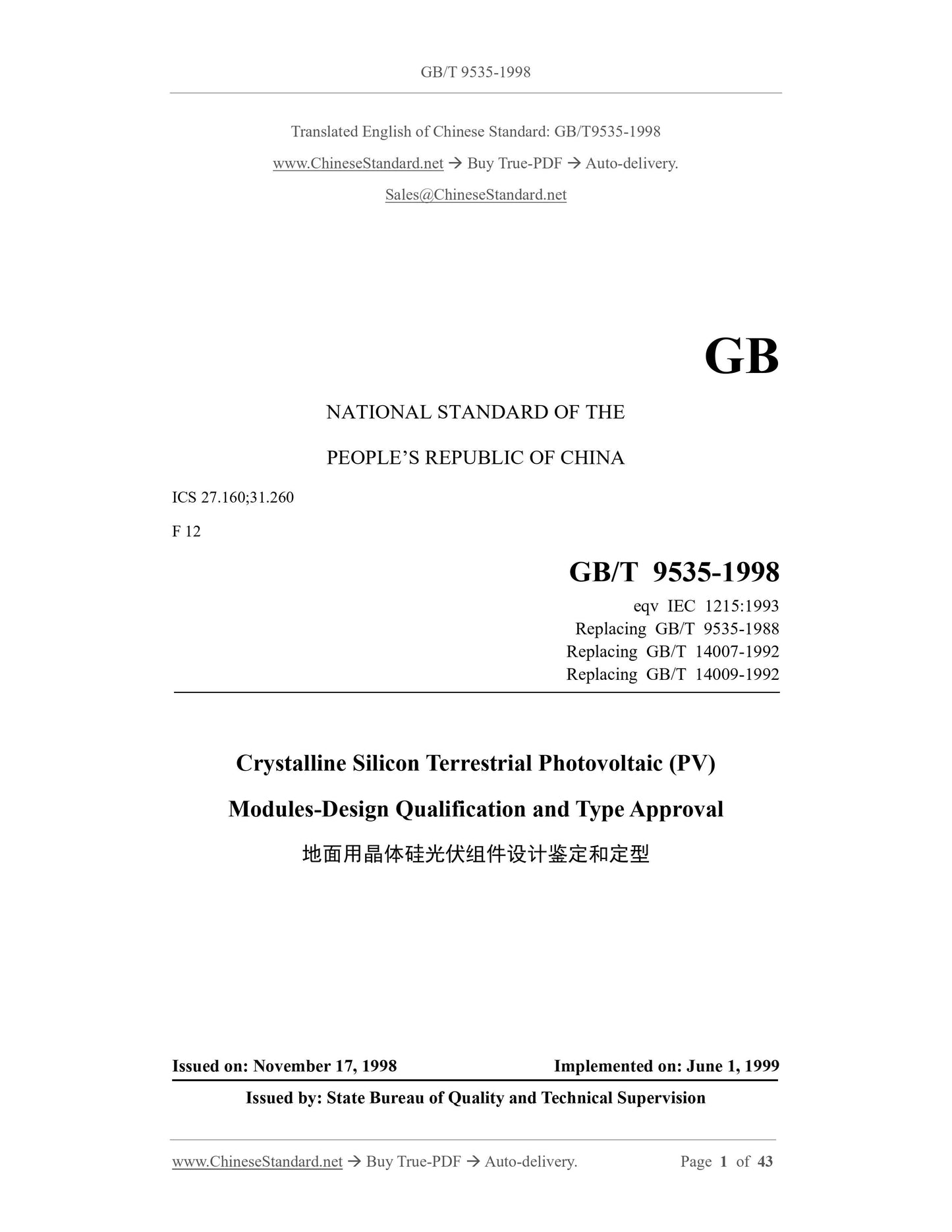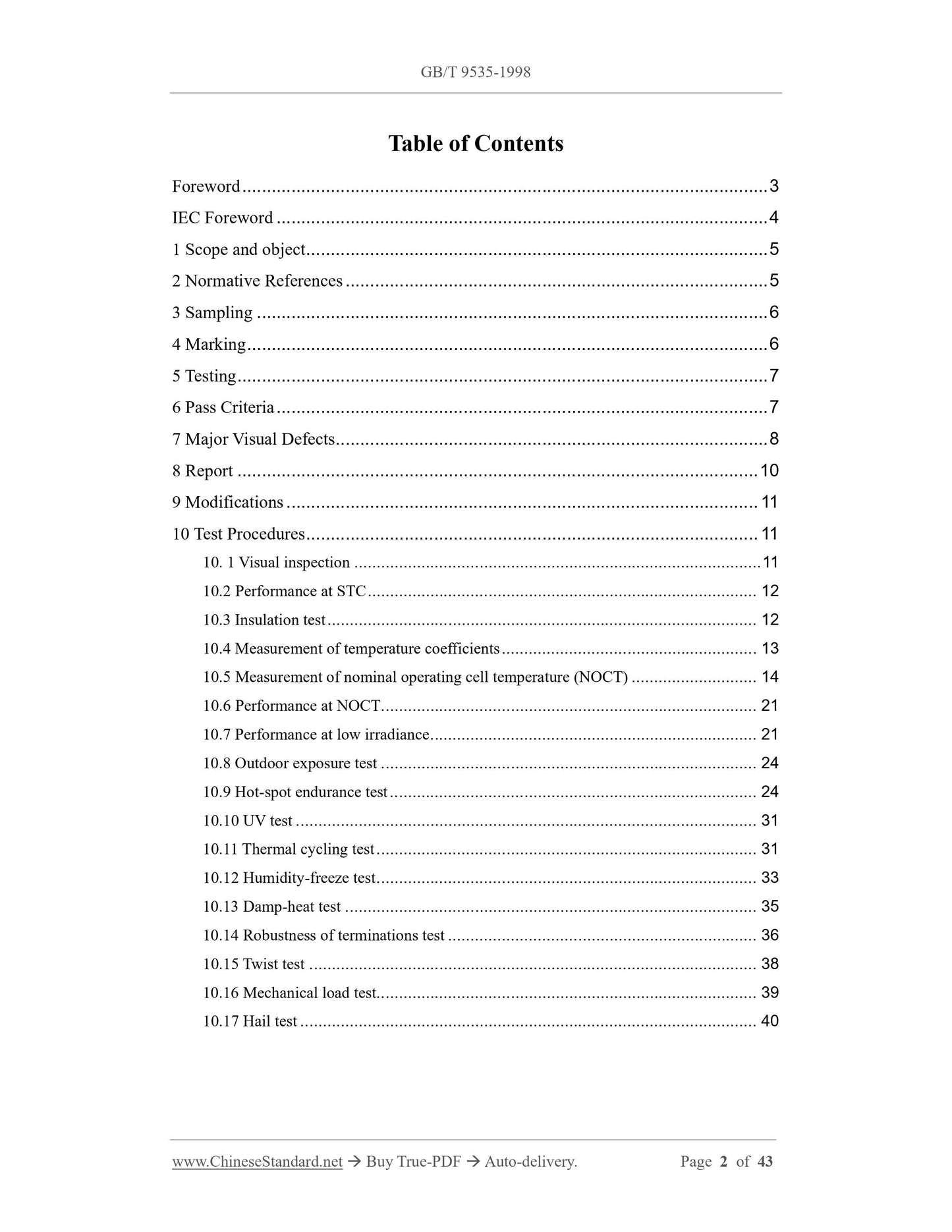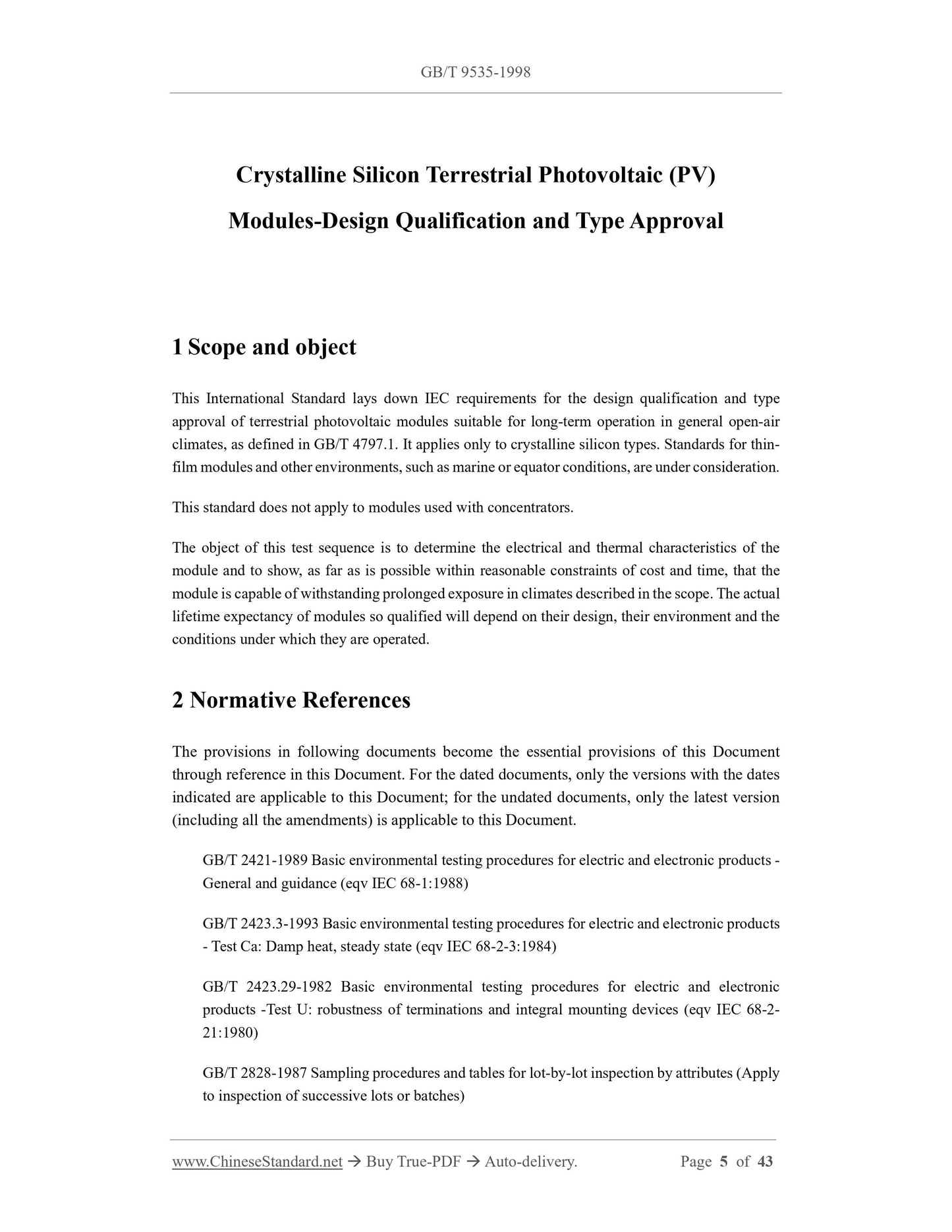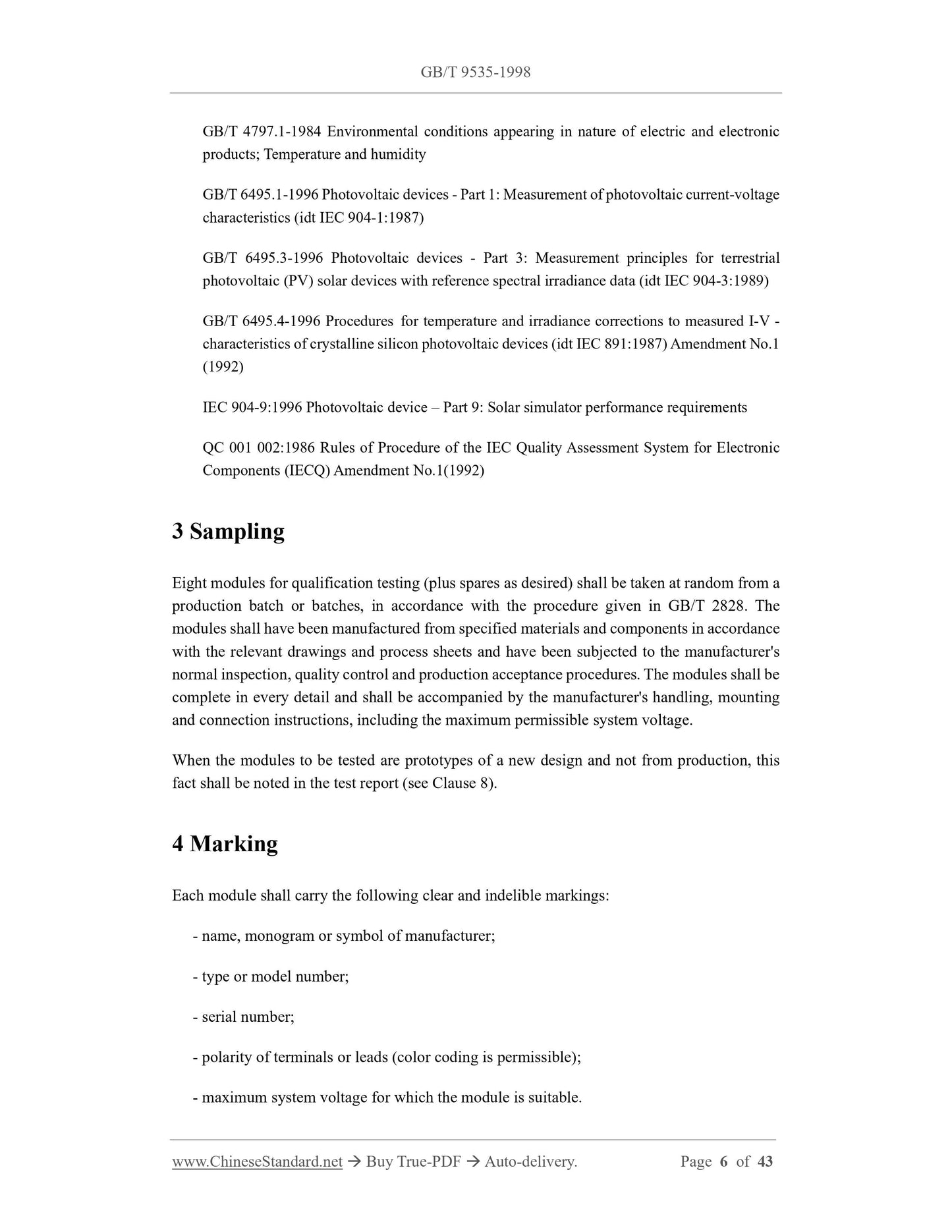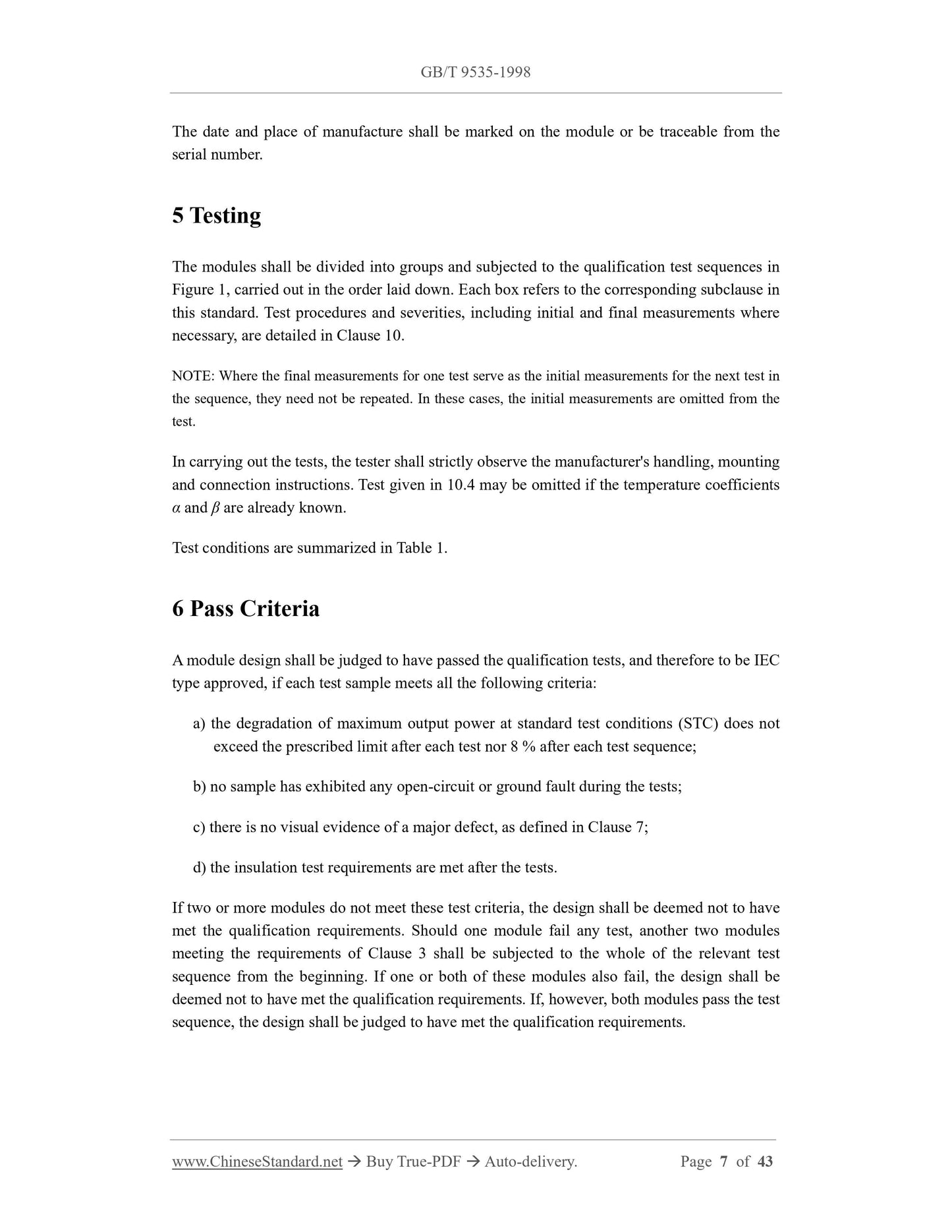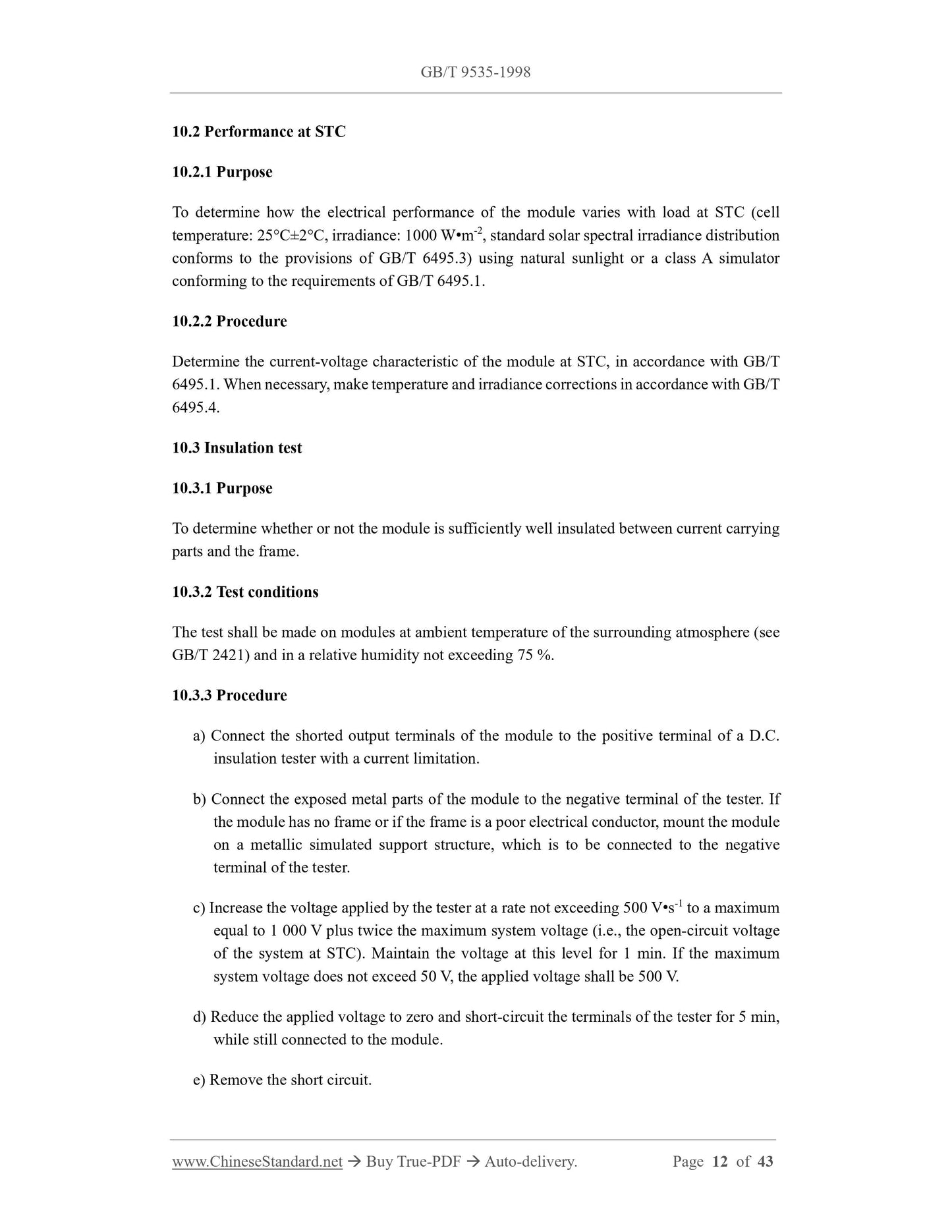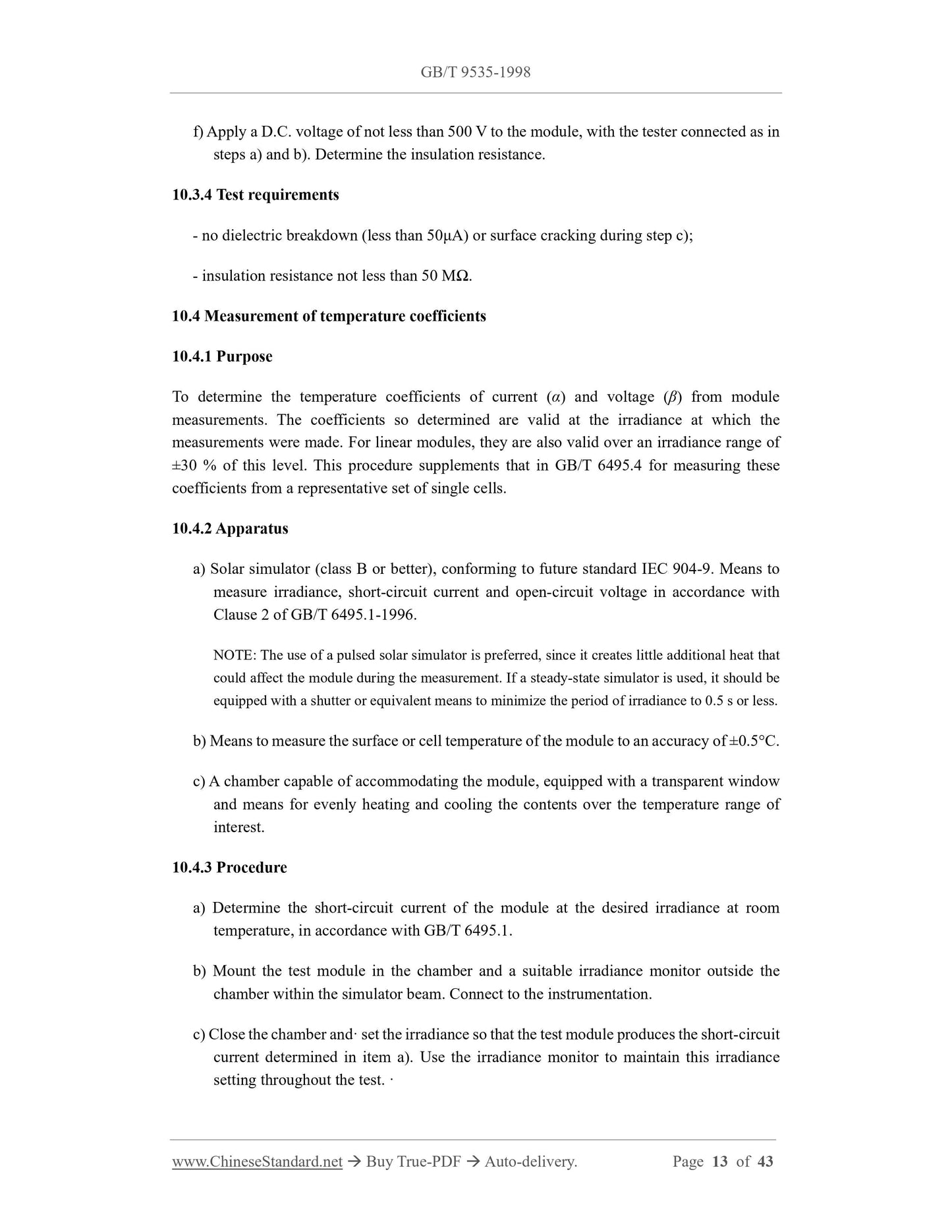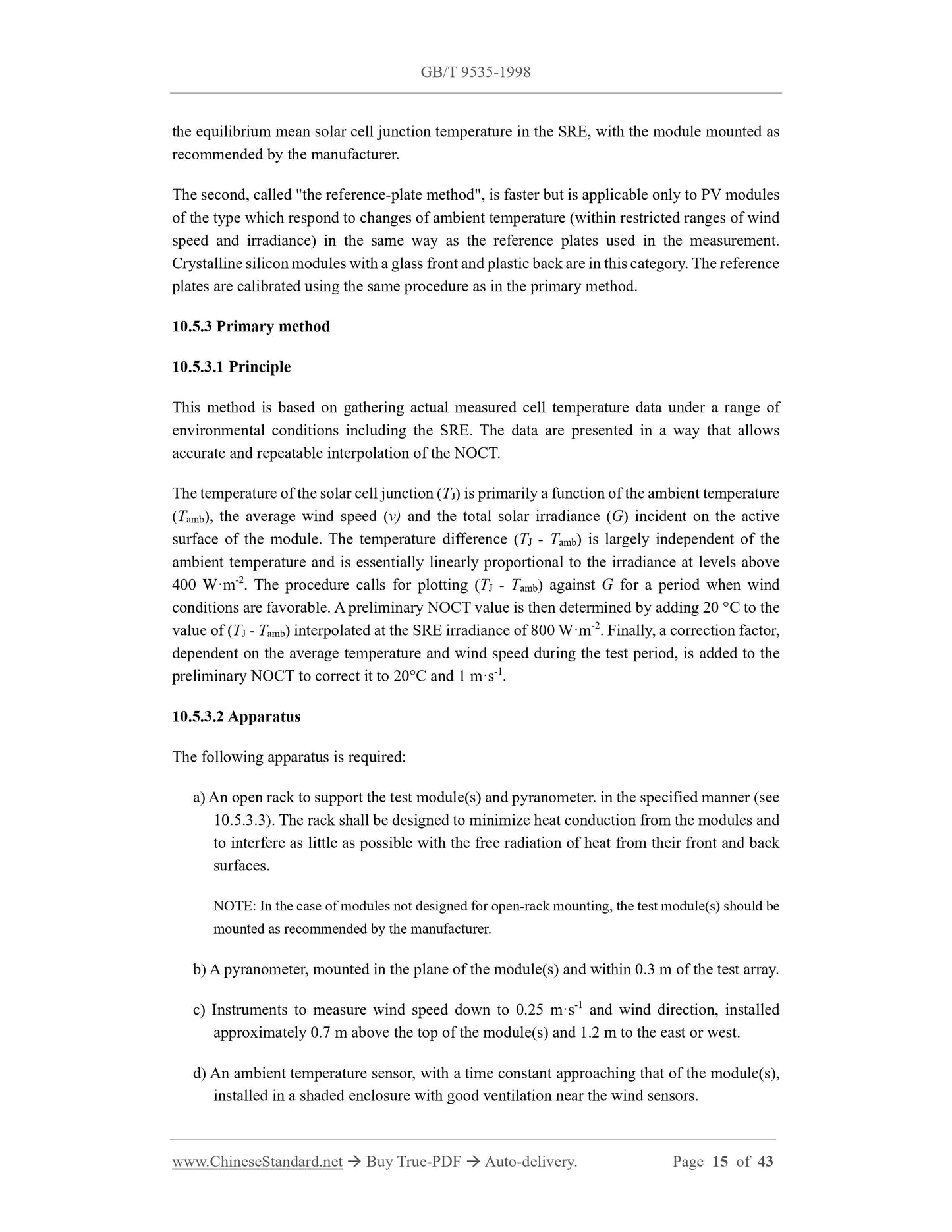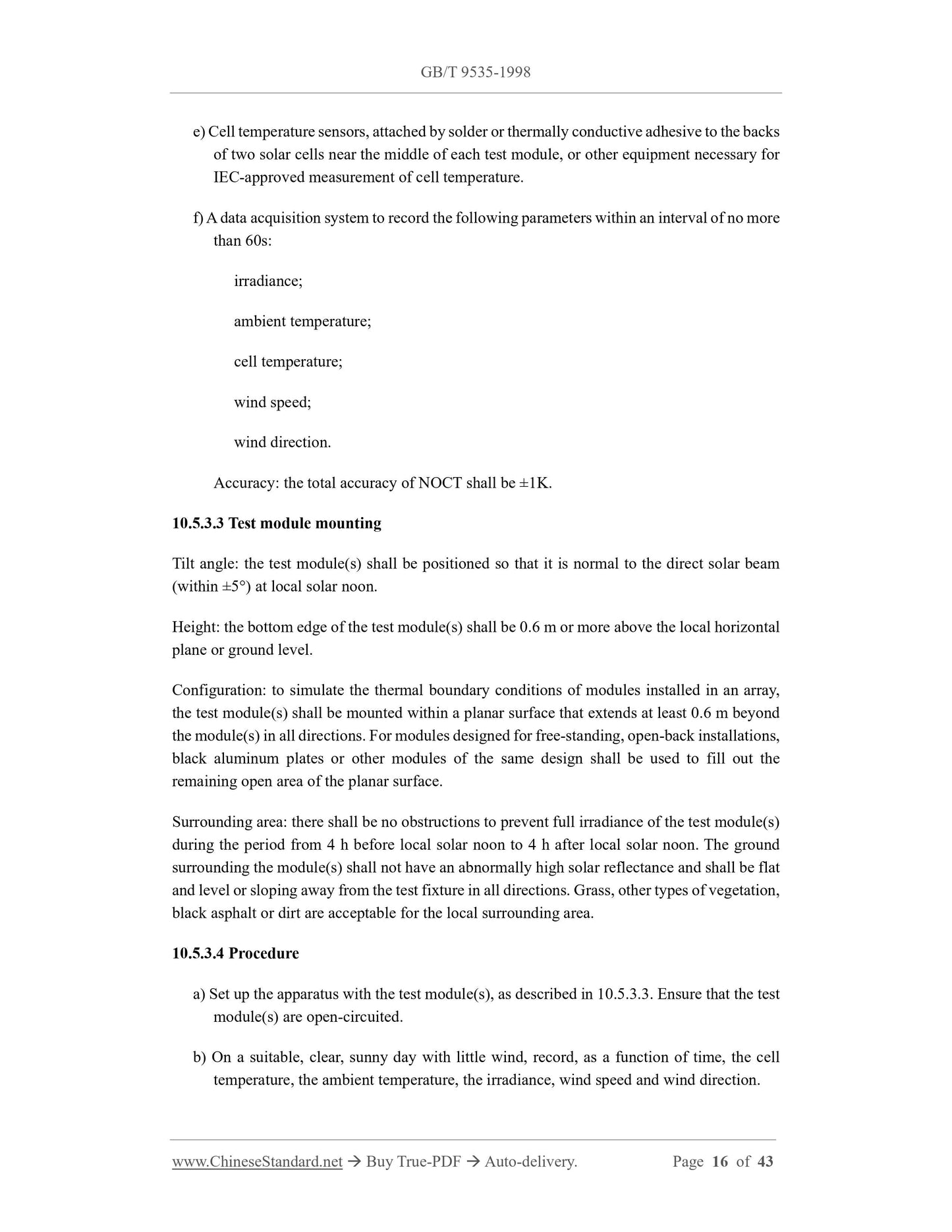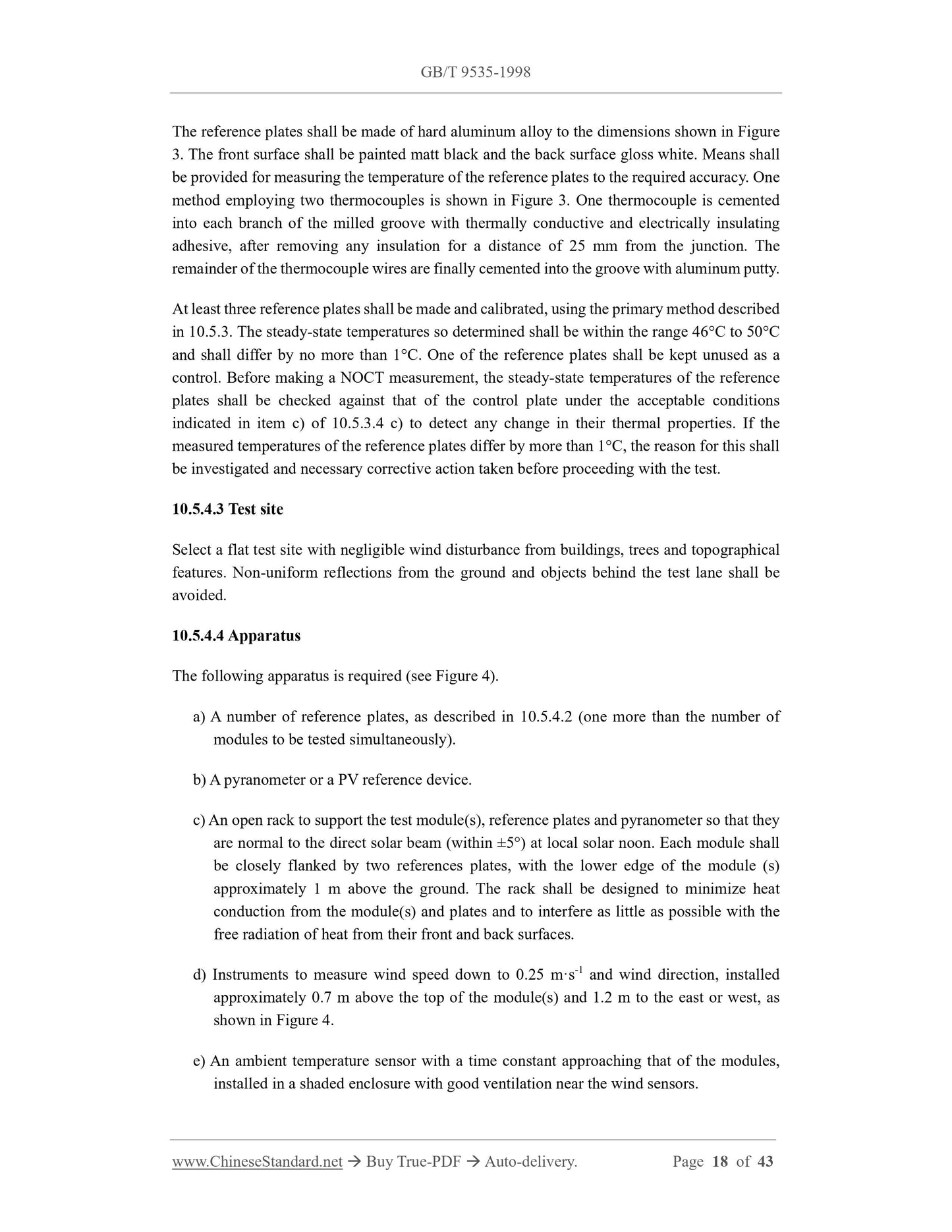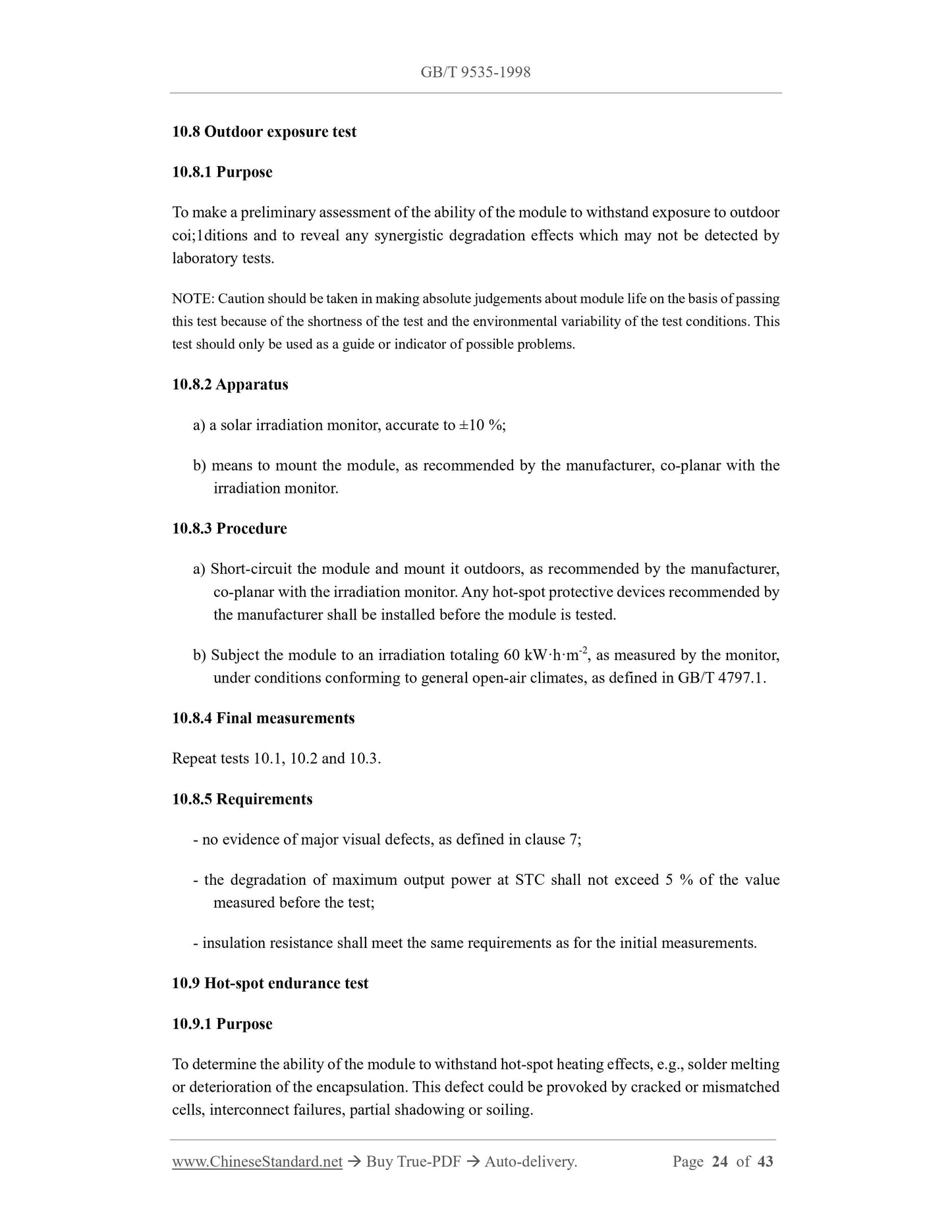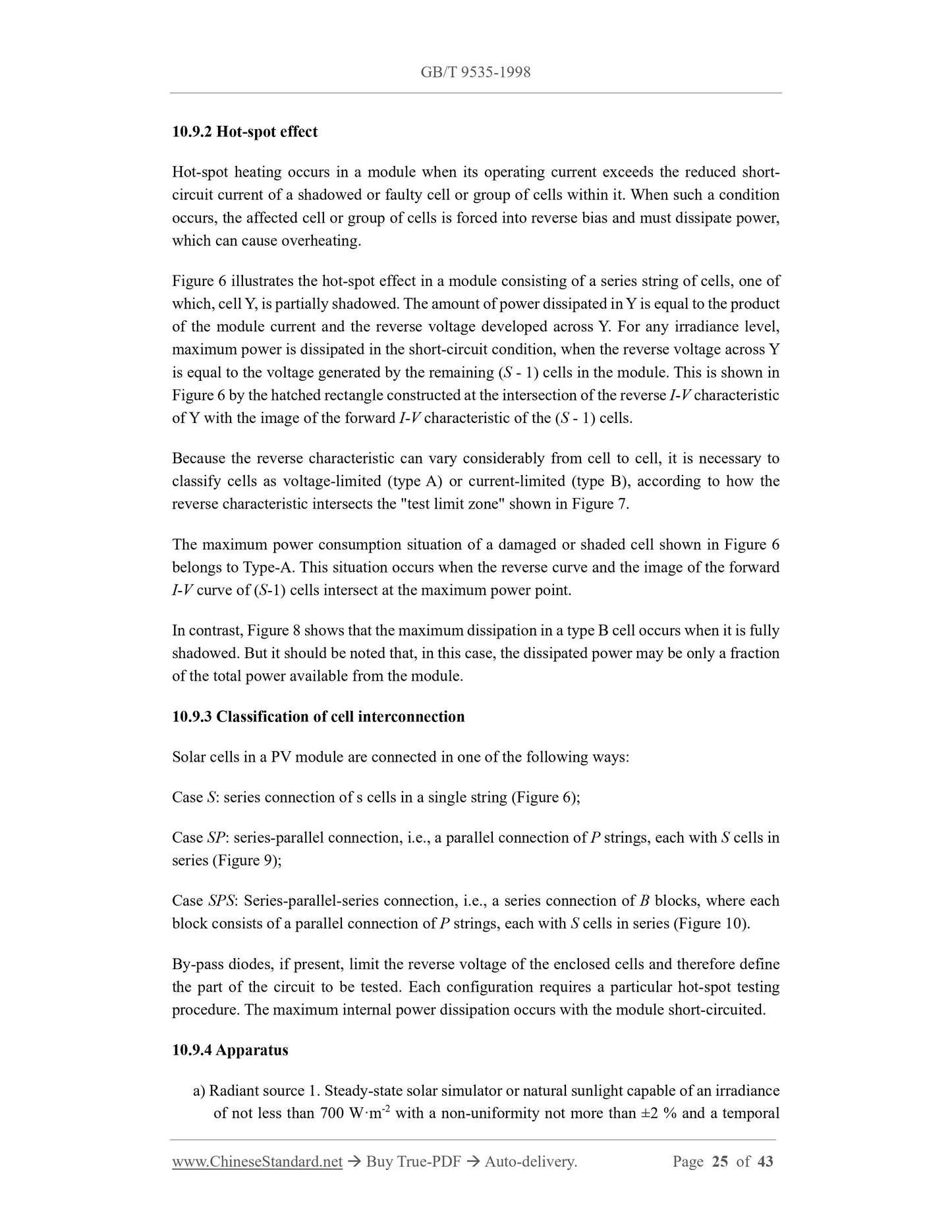1
/
of
12
www.ChineseStandard.us -- Field Test Asia Pte. Ltd.
GB/T 9535-1998 English PDF (GB/T9535-1998)
GB/T 9535-1998 English PDF (GB/T9535-1998)
Regular price
$350.00
Regular price
Sale price
$350.00
Unit price
/
per
Shipping calculated at checkout.
Couldn't load pickup availability
GB/T 9535-1998: Crystalline silicon terrestrial photovoltaic(PV) modules-design qualification and type approval
Delivery: 9 seconds. Download (& Email) true-PDF + Invoice.
Get Quotation: Click GB/T 9535-1998 (Self-service in 1-minute)
Historical versions (Master-website): GB/T 9535-1998
Preview True-PDF (Reload/Scroll-down if blank)
GB/T 9535-1998
GB
NATIONAL STANDARD OF THE
PEOPLE’S REPUBLIC OF CHINA
ICS 27.160;31.260
F 12
eqv IEC 1215:1993
Replacing GB/T 9535-1988
Replacing GB/T 14007-1992
Replacing GB/T 14009-1992
Crystalline Silicon Terrestrial Photovoltaic (PV)
Modules-Design Qualification and Type Approval
ISSUED ON: NOVEMBER 17, 1998
IMPLEMENTED ON: JUNE 1, 1999
Issued by: State Bureau of Quality and Technical Supervision
Table of Contents
Foreword ... 3
IEC Foreword ... 4
1 Scope and object ... 5
2 Normative References ... 5
3 Sampling ... 6
4 Marking ... 6
5 Testing ... 7
6 Pass Criteria ... 7
7 Major Visual Defects ... 8
8 Report ... 10
9 Modifications ... 11
10 Test Procedures ... 11
10. 1 Visual inspection ... 11
10.2 Performance at STC ... 12
10.3 Insulation test ... 12
10.4 Measurement of temperature coefficients ... 13
10.5 Measurement of nominal operating cell temperature (NOCT) ... 14
10.6 Performance at NOCT... 21
10.7 Performance at low irradiance ... 21
10.8 Outdoor exposure test ... 24
10.9 Hot-spot endurance test ... 24
10.10 UV test ... 31
10.11 Thermal cycling test ... 31
10.12 Humidity-freeze test ... 33
10.13 Damp-heat test ... 35
10.14 Robustness of terminations test ... 36
10.15 Twist test ... 38
10.16 Mechanical load test... 39
10.17 Hail test ... 40
Crystalline Silicon Terrestrial Photovoltaic (PV)
Modules-Design Qualification and Type Approval
1 Scope and object
This International Standard lays down IEC requirements for the design qualification and type
approval of terrestrial photovoltaic modules suitable for long-term operation in general open-air
climates, as defined in GB/T 4797.1. It applies only to crystalline silicon types. Standards for thin-
film modules and other environments, such as marine or equator conditions, are under consideration.
This standard does not apply to modules used with concentrators.
The object of this test sequence is to determine the electrical and thermal characteristics of the
module and to show, as far as is possible within reasonable constraints of cost and time, that the
module is capable of withstanding prolonged exposure in climates described in the scope. The actual
lifetime expectancy of modules so qualified will depend on their design, their environment and the
conditions under which they are operated.
2 Normative References
The provisions in following documents become the essential provisions of this Document
through reference in this Document. For the dated documents, only the versions with the dates
indicated are applicable to this Document; for the undated documents, only the latest version
(including all the amendments) is applicable to this Document.
GB/T 2421-1989 Basic environmental testing procedures for electric and electronic products -
General and guidance (eqv IEC 68-1:1988)
GB/T 2423.3-1993 Basic environmental testing procedures for electric and electronic products
- Test Ca: Damp heat, steady state (eqv IEC 68-2-3:1984)
GB/T 2423.29-1982 Basic environmental testing procedures for electric and electronic
products -Test U: robustness of terminations and integral mounting devices (eqv IEC 68-2-
21:1980)
GB/T 2828-1987 Sampling procedures and tables for lot-by-lot inspection by attributes (Apply
to inspection of successive lots or batches)
GB/T 4797.1-1984 Environmental conditions appearing in nature of electric and electronic
products; Temperature and humidity
GB/T 6495.1-1996 Photovoltaic devices - Part 1: Measurement of photovoltaic current-voltage
characteristics (idt IEC 904-1:1987)
GB/T 6495.3-1996 Photovoltaic devices - Part 3: Measurement principles for terrestrial
photovoltaic (PV) solar devices with reference spectral irradiance data (idt IEC 904-3:1989)
GB/T 6495.4-1996 Procedures for temperature and irradiance corrections to measured I-V -
characteristics of crystalline silicon photovoltaic devices (idt IEC 891:1987) Amendment No.1
(1992)
IEC 904-9:1996 Photovoltaic device – Part 9: Solar simulator performance requirements
QC 001 002:1986 Rules of Procedure of the IEC Quality Assessment System for Electronic
Components (IECQ) Amendment No.1(1992)
3 Sampling
Eight modules for qualification testing (plus spares as desired) shall be taken at random from a
production batch or batches, in accordance with the procedure given in GB/T 2828. The
modules shall have been manufactured from specified materials and components in accordance
with the relevant drawings and process sheets and have been subjected to the manufacturer's
normal inspection, quality control and production acceptance procedures. The modules shall be
complete in every detail and shall be accompanied by the manufacturer's handling, mounting
and connection instructions, including the maximum permissible system voltage.
When the modules to be tested are prototypes of a new design and not from production, this
fact shall be noted in the test report (see Clause 8).
4 Marking
Each module shall carry the following clear and indelible markings:
- name, monogram or symbol of manufacturer;
- type or model number;
- serial number;
- polarity of terminals or leads (color coding is permissible);
- maximum system voltage for which the module is suitable.
The date and place of manufacture shall be marked on the module or be traceable from the
serial number.
5 Testing
The modules shall be divided into groups and subjected to the qualification test sequences in
Figure 1, carried out in the order laid down. Each box refers to the corresponding subclause in
this standard. Test procedures and severities, including initial and final measurements where
necessary, are detailed in Clause 10.
NOTE: Where the final measurements for one test serve as the initial measurements for the next test in
the sequence, they need not be repeated. In these cases, the initial measurements are omitted from the
test.
In carrying out the tests, the tester shall strictly observe the manufacturer's handling, mounting
and connection instructions. Test given in 10.4 may be omitted if the temperature coefficients
α and β are already known.
Test conditions are summarized in Table 1.
6 Pass Criteria
A module design shall be judged to have passed the qualification tests, and therefore to be IEC
type approved, if each test sample meets all the following criteria:
a) the degradation of maximum output power at standard test conditions (STC) does not
exceed the prescribed limit after each test nor 8 % after each test sequence;
b) no sample has exhibited any open-circuit or ground fault during the tests;
c) there is no visual evidence of a major defect, as defined in Clause 7;
d) the insulation test requirements are met after the tests.
If two or more modules do not meet these test criteria, the design shall be deemed not to have
met the qualification requirements. Should one module fail any test, another two modules
meeting the requirements of Clause 3 shall be subjected to the whole of the relevant test
sequence from the beginning. If one or both of these modules also fail, the design shall be
deemed not to have met the qualification requirements. If, however, both modules pass the test
sequence, the design shall be judged to have met the qualification requirements.
10.2 Performance at STC
10.2.1 Purpose
To determine how the electrical performance of the module varies with load at STC (cell
temperature: 25°C±2°C, irradiance: 1000 W•m-2, standard solar spectral irradiance distribution
conforms to the provisions of GB/T 6495.3) using natural sunlight or a class A simulator
conforming to the requirements of GB/T 6495.1.
10.2.2 Procedure
Determine the current-voltage characteristic of the module at STC, in accordance with GB/T
6495.1. When necessary, make temperature and irradiance corrections in accordance with GB/T
6495.4.
10.3 Insulation test
10.3.1 Purpose
To determine whether or not the module is sufficiently well insulated between current carrying
parts and the frame.
10.3.2 Test conditions
The test shall be made on modules at ambient temperature of the surrounding atmosphere (see
GB/T 2421) and in a relative humidity not exceeding 75 %.
10.3.3 Procedure
a) Connect the shorted output terminals of the module to the positive terminal of a D.C.
insulation tester with a current limitation.
b) Connect the exposed metal parts of the module to the negative terminal of the tester. If
the module has no frame or if the frame is a poor electrical conductor, mount the module
on a metallic simulated support structure, which is to be connected to the negative
terminal of the tester.
c) Increase the voltage applied by the tester at a rate not exceeding 500 V•s-1 to a maximum
equal to 1 000 V plus twice the maximum system voltage (i.e., the open-circuit voltage
of the system at STC). Maintain the voltage at this level for 1 min. If the maximum
system voltage does not exceed 50 V, the applied voltage shall be 500 V.
d) Reduce the applied voltage to zero and short-circuit the terminals of the tester for 5 min,
while still connected to the module.
e) Remove the short circuit.
f) Apply a D.C. voltage of not less than 500 V to the module, with the tester connected as in
steps a) and b). Determine the insulation resistance.
10.3.4 Test requirements
- no dielectric breakdown (less than 50μA) or surface cracking during step c);
- insulation resistance not less than 50 MΩ.
10.4 Measurement of temperature coefficients
10.4.1 Purpose
To determine the temperature coefficients of current (α) and voltage (β) from module
measurements. The coefficients so determined are valid at the irradiance at which the
measurements were made. For linear modules, they are also valid over an irradiance range of
±30 % of this level. This procedure supplements that in GB/T 6495.4 for measuring these
coefficients from a representative set of single cells.
10.4.2 Apparatus
a) Solar simulator (class B or better), conforming to future standard IEC 904-9. Means to
measure irradiance, short-circuit current and open-circuit voltage in accordance with
Clause 2 of GB/T 6495.1-1996.
NOTE: The use of a pulsed solar simulator is preferred, since it creates little additional heat that
could affect the module during the measurement. If a steady-state simulator is used, it should be
equipped with a shutter or equivalent means to minimize the period of irradiance to 0.5 s or less.
b) Means to measure the surface or cell temperature of the module to an accuracy of ±0.5°C.
c) A chamber capable of accommodating the module, equipped with a transparent window
and means for evenly heating and cooling the contents over the temperature range of
interest.
10.4.3 Procedure
a) Determine the short-circuit current of the module at the desired irradiance at room
temperature, in accordance with GB/T 6495.1.
b) Mount the test module in the chamber and a suitable irradiance monitor outside the
chamber within the simulator beam. Connect to the instrumentation.
c) Close the chamber and· set the irradiance so that the test module produces the short-circuit
current determined in item a). Use the irradiance monitor to maintain this irradiance
setting throughout the test...
the equilibrium mean solar cell junction temperature in the SRE, with the module mounted as
recommended by the manufacturer.
The second, called "the reference-plate method", is faster but is applicable only to PV modules
of the type which respond to changes of ambient temperature (within restricted ranges of wind
speed and irradiance) in the same way as the reference plates used in the measurement.
Crystalline silicon modules with a glass front and plastic back are in this category. The reference
plates are calibrated using the same procedure as in the primary method.
10.5.3 Primary method
10.5.3.1 Principle
This method is based on gathering actual measured cell temperature data under a range of
environmental conditions including the SRE. The data are presented in a way that allows
accurate and repeatable interpolation of the NOCT.
The temperature of the solar cell junction (TJ) is primarily a function of the ambient temperature
(Tamb), the average wind speed (v) and the total solar irradiance (G) incident on the active
surface of the module. The temperature difference (TJ - Tamb) is largely independent of the
ambient temperature and is essentially linearly proportional to the irradiance at levels above
400 W·m-2. The procedure calls for plotting (TJ - Tamb) against G for a period when wind
conditions are favorable. A preliminary NOCT value is then determined by adding 20 °C to the
value of (TJ - Tamb) interpolated at the SRE irradiance of 800 W·m-2. Finally, a correction factor,
dependent on the average temperature and wind speed during the test period, is added to the
preliminary NOCT to correct it to 20°C and 1 m·s-1.
10.5.3.2 Apparatus
The following apparatus is required:
a) An open rack to support the test module(s) and pyranometer. in the specified manner (see
10.5.3.3). The rack shall be designed to minimize heat conduction from the modules and
to interfere as little as possible with the free radiation of heat from their front and back
surfaces.
NOTE: In the case of modules not designed for open-rack mounting, the test module(s) should be
mounted as recommended by the manufacturer.
b) A pyranometer, mounted in the plane of the module(s) and within 0.3 m of the test array.
c) Instruments to measure wind speed down to 0.25 m·s-1 and wind direction, installed
approximately 0.7 m above the top of the module(s) and 1.2 m to the east or west.
d) An ambient temperature sensor, with a time constant approaching that of the module(s),
installed in a shaded enclosure with good ventilation near the wind sensors.
e) Cell temperature sensors, attached by solder or thermally conductive adhesive to the backs
of two solar cells near the middle of each test module, or other equipment necessary for
IEC-approved measurement of cell temperature.
f) A d...
Delivery: 9 seconds. Download (& Email) true-PDF + Invoice.
Get Quotation: Click GB/T 9535-1998 (Self-service in 1-minute)
Historical versions (Master-website): GB/T 9535-1998
Preview True-PDF (Reload/Scroll-down if blank)
GB/T 9535-1998
GB
NATIONAL STANDARD OF THE
PEOPLE’S REPUBLIC OF CHINA
ICS 27.160;31.260
F 12
eqv IEC 1215:1993
Replacing GB/T 9535-1988
Replacing GB/T 14007-1992
Replacing GB/T 14009-1992
Crystalline Silicon Terrestrial Photovoltaic (PV)
Modules-Design Qualification and Type Approval
ISSUED ON: NOVEMBER 17, 1998
IMPLEMENTED ON: JUNE 1, 1999
Issued by: State Bureau of Quality and Technical Supervision
Table of Contents
Foreword ... 3
IEC Foreword ... 4
1 Scope and object ... 5
2 Normative References ... 5
3 Sampling ... 6
4 Marking ... 6
5 Testing ... 7
6 Pass Criteria ... 7
7 Major Visual Defects ... 8
8 Report ... 10
9 Modifications ... 11
10 Test Procedures ... 11
10. 1 Visual inspection ... 11
10.2 Performance at STC ... 12
10.3 Insulation test ... 12
10.4 Measurement of temperature coefficients ... 13
10.5 Measurement of nominal operating cell temperature (NOCT) ... 14
10.6 Performance at NOCT... 21
10.7 Performance at low irradiance ... 21
10.8 Outdoor exposure test ... 24
10.9 Hot-spot endurance test ... 24
10.10 UV test ... 31
10.11 Thermal cycling test ... 31
10.12 Humidity-freeze test ... 33
10.13 Damp-heat test ... 35
10.14 Robustness of terminations test ... 36
10.15 Twist test ... 38
10.16 Mechanical load test... 39
10.17 Hail test ... 40
Crystalline Silicon Terrestrial Photovoltaic (PV)
Modules-Design Qualification and Type Approval
1 Scope and object
This International Standard lays down IEC requirements for the design qualification and type
approval of terrestrial photovoltaic modules suitable for long-term operation in general open-air
climates, as defined in GB/T 4797.1. It applies only to crystalline silicon types. Standards for thin-
film modules and other environments, such as marine or equator conditions, are under consideration.
This standard does not apply to modules used with concentrators.
The object of this test sequence is to determine the electrical and thermal characteristics of the
module and to show, as far as is possible within reasonable constraints of cost and time, that the
module is capable of withstanding prolonged exposure in climates described in the scope. The actual
lifetime expectancy of modules so qualified will depend on their design, their environment and the
conditions under which they are operated.
2 Normative References
The provisions in following documents become the essential provisions of this Document
through reference in this Document. For the dated documents, only the versions with the dates
indicated are applicable to this Document; for the undated documents, only the latest version
(including all the amendments) is applicable to this Document.
GB/T 2421-1989 Basic environmental testing procedures for electric and electronic products -
General and guidance (eqv IEC 68-1:1988)
GB/T 2423.3-1993 Basic environmental testing procedures for electric and electronic products
- Test Ca: Damp heat, steady state (eqv IEC 68-2-3:1984)
GB/T 2423.29-1982 Basic environmental testing procedures for electric and electronic
products -Test U: robustness of terminations and integral mounting devices (eqv IEC 68-2-
21:1980)
GB/T 2828-1987 Sampling procedures and tables for lot-by-lot inspection by attributes (Apply
to inspection of successive lots or batches)
GB/T 4797.1-1984 Environmental conditions appearing in nature of electric and electronic
products; Temperature and humidity
GB/T 6495.1-1996 Photovoltaic devices - Part 1: Measurement of photovoltaic current-voltage
characteristics (idt IEC 904-1:1987)
GB/T 6495.3-1996 Photovoltaic devices - Part 3: Measurement principles for terrestrial
photovoltaic (PV) solar devices with reference spectral irradiance data (idt IEC 904-3:1989)
GB/T 6495.4-1996 Procedures for temperature and irradiance corrections to measured I-V -
characteristics of crystalline silicon photovoltaic devices (idt IEC 891:1987) Amendment No.1
(1992)
IEC 904-9:1996 Photovoltaic device – Part 9: Solar simulator performance requirements
QC 001 002:1986 Rules of Procedure of the IEC Quality Assessment System for Electronic
Components (IECQ) Amendment No.1(1992)
3 Sampling
Eight modules for qualification testing (plus spares as desired) shall be taken at random from a
production batch or batches, in accordance with the procedure given in GB/T 2828. The
modules shall have been manufactured from specified materials and components in accordance
with the relevant drawings and process sheets and have been subjected to the manufacturer's
normal inspection, quality control and production acceptance procedures. The modules shall be
complete in every detail and shall be accompanied by the manufacturer's handling, mounting
and connection instructions, including the maximum permissible system voltage.
When the modules to be tested are prototypes of a new design and not from production, this
fact shall be noted in the test report (see Clause 8).
4 Marking
Each module shall carry the following clear and indelible markings:
- name, monogram or symbol of manufacturer;
- type or model number;
- serial number;
- polarity of terminals or leads (color coding is permissible);
- maximum system voltage for which the module is suitable.
The date and place of manufacture shall be marked on the module or be traceable from the
serial number.
5 Testing
The modules shall be divided into groups and subjected to the qualification test sequences in
Figure 1, carried out in the order laid down. Each box refers to the corresponding subclause in
this standard. Test procedures and severities, including initial and final measurements where
necessary, are detailed in Clause 10.
NOTE: Where the final measurements for one test serve as the initial measurements for the next test in
the sequence, they need not be repeated. In these cases, the initial measurements are omitted from the
test.
In carrying out the tests, the tester shall strictly observe the manufacturer's handling, mounting
and connection instructions. Test given in 10.4 may be omitted if the temperature coefficients
α and β are already known.
Test conditions are summarized in Table 1.
6 Pass Criteria
A module design shall be judged to have passed the qualification tests, and therefore to be IEC
type approved, if each test sample meets all the following criteria:
a) the degradation of maximum output power at standard test conditions (STC) does not
exceed the prescribed limit after each test nor 8 % after each test sequence;
b) no sample has exhibited any open-circuit or ground fault during the tests;
c) there is no visual evidence of a major defect, as defined in Clause 7;
d) the insulation test requirements are met after the tests.
If two or more modules do not meet these test criteria, the design shall be deemed not to have
met the qualification requirements. Should one module fail any test, another two modules
meeting the requirements of Clause 3 shall be subjected to the whole of the relevant test
sequence from the beginning. If one or both of these modules also fail, the design shall be
deemed not to have met the qualification requirements. If, however, both modules pass the test
sequence, the design shall be judged to have met the qualification requirements.
10.2 Performance at STC
10.2.1 Purpose
To determine how the electrical performance of the module varies with load at STC (cell
temperature: 25°C±2°C, irradiance: 1000 W•m-2, standard solar spectral irradiance distribution
conforms to the provisions of GB/T 6495.3) using natural sunlight or a class A simulator
conforming to the requirements of GB/T 6495.1.
10.2.2 Procedure
Determine the current-voltage characteristic of the module at STC, in accordance with GB/T
6495.1. When necessary, make temperature and irradiance corrections in accordance with GB/T
6495.4.
10.3 Insulation test
10.3.1 Purpose
To determine whether or not the module is sufficiently well insulated between current carrying
parts and the frame.
10.3.2 Test conditions
The test shall be made on modules at ambient temperature of the surrounding atmosphere (see
GB/T 2421) and in a relative humidity not exceeding 75 %.
10.3.3 Procedure
a) Connect the shorted output terminals of the module to the positive terminal of a D.C.
insulation tester with a current limitation.
b) Connect the exposed metal parts of the module to the negative terminal of the tester. If
the module has no frame or if the frame is a poor electrical conductor, mount the module
on a metallic simulated support structure, which is to be connected to the negative
terminal of the tester.
c) Increase the voltage applied by the tester at a rate not exceeding 500 V•s-1 to a maximum
equal to 1 000 V plus twice the maximum system voltage (i.e., the open-circuit voltage
of the system at STC). Maintain the voltage at this level for 1 min. If the maximum
system voltage does not exceed 50 V, the applied voltage shall be 500 V.
d) Reduce the applied voltage to zero and short-circuit the terminals of the tester for 5 min,
while still connected to the module.
e) Remove the short circuit.
f) Apply a D.C. voltage of not less than 500 V to the module, with the tester connected as in
steps a) and b). Determine the insulation resistance.
10.3.4 Test requirements
- no dielectric breakdown (less than 50μA) or surface cracking during step c);
- insulation resistance not less than 50 MΩ.
10.4 Measurement of temperature coefficients
10.4.1 Purpose
To determine the temperature coefficients of current (α) and voltage (β) from module
measurements. The coefficients so determined are valid at the irradiance at which the
measurements were made. For linear modules, they are also valid over an irradiance range of
±30 % of this level. This procedure supplements that in GB/T 6495.4 for measuring these
coefficients from a representative set of single cells.
10.4.2 Apparatus
a) Solar simulator (class B or better), conforming to future standard IEC 904-9. Means to
measure irradiance, short-circuit current and open-circuit voltage in accordance with
Clause 2 of GB/T 6495.1-1996.
NOTE: The use of a pulsed solar simulator is preferred, since it creates little additional heat that
could affect the module during the measurement. If a steady-state simulator is used, it should be
equipped with a shutter or equivalent means to minimize the period of irradiance to 0.5 s or less.
b) Means to measure the surface or cell temperature of the module to an accuracy of ±0.5°C.
c) A chamber capable of accommodating the module, equipped with a transparent window
and means for evenly heating and cooling the contents over the temperature range of
interest.
10.4.3 Procedure
a) Determine the short-circuit current of the module at the desired irradiance at room
temperature, in accordance with GB/T 6495.1.
b) Mount the test module in the chamber and a suitable irradiance monitor outside the
chamber within the simulator beam. Connect to the instrumentation.
c) Close the chamber and· set the irradiance so that the test module produces the short-circuit
current determined in item a). Use the irradiance monitor to maintain this irradiance
setting throughout the test...
the equilibrium mean solar cell junction temperature in the SRE, with the module mounted as
recommended by the manufacturer.
The second, called "the reference-plate method", is faster but is applicable only to PV modules
of the type which respond to changes of ambient temperature (within restricted ranges of wind
speed and irradiance) in the same way as the reference plates used in the measurement.
Crystalline silicon modules with a glass front and plastic back are in this category. The reference
plates are calibrated using the same procedure as in the primary method.
10.5.3 Primary method
10.5.3.1 Principle
This method is based on gathering actual measured cell temperature data under a range of
environmental conditions including the SRE. The data are presented in a way that allows
accurate and repeatable interpolation of the NOCT.
The temperature of the solar cell junction (TJ) is primarily a function of the ambient temperature
(Tamb), the average wind speed (v) and the total solar irradiance (G) incident on the active
surface of the module. The temperature difference (TJ - Tamb) is largely independent of the
ambient temperature and is essentially linearly proportional to the irradiance at levels above
400 W·m-2. The procedure calls for plotting (TJ - Tamb) against G for a period when wind
conditions are favorable. A preliminary NOCT value is then determined by adding 20 °C to the
value of (TJ - Tamb) interpolated at the SRE irradiance of 800 W·m-2. Finally, a correction factor,
dependent on the average temperature and wind speed during the test period, is added to the
preliminary NOCT to correct it to 20°C and 1 m·s-1.
10.5.3.2 Apparatus
The following apparatus is required:
a) An open rack to support the test module(s) and pyranometer. in the specified manner (see
10.5.3.3). The rack shall be designed to minimize heat conduction from the modules and
to interfere as little as possible with the free radiation of heat from their front and back
surfaces.
NOTE: In the case of modules not designed for open-rack mounting, the test module(s) should be
mounted as recommended by the manufacturer.
b) A pyranometer, mounted in the plane of the module(s) and within 0.3 m of the test array.
c) Instruments to measure wind speed down to 0.25 m·s-1 and wind direction, installed
approximately 0.7 m above the top of the module(s) and 1.2 m to the east or west.
d) An ambient temperature sensor, with a time constant approaching that of the module(s),
installed in a shaded enclosure with good ventilation near the wind sensors.
e) Cell temperature sensors, attached by solder or thermally conductive adhesive to the backs
of two solar cells near the middle of each test module, or other equipment necessary for
IEC-approved measurement of cell temperature.
f) A d...
Share
